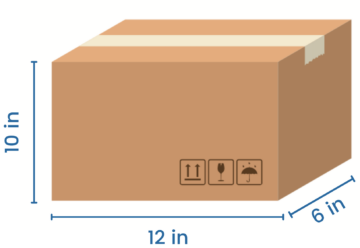
Introduction
Dimensional weight, also known as volumetric weight, is a pricing technique that commercial freight transport companies have widely adopted. By calculating the space a package occupies in a truck, aircraft, or ship, rather than only its gross weight, freight carriers can optimize their cargo and ensure profitability. This practice has seen widespread adoption since 2015 and has become a norm among leading shipping companies, including USPS, UPS, FedEx, Canada Post, and DHL.
However, not all shipping companies calculate their DIM weights the same. In this blog, we’ll unpack the ways these shipping companies calculate dimensional weight and offer practical examples to help you vizualize how different shipping carriers can impact your DIM Weight costs.
Jump right in: Dimensional Weight Across Leading Carriers
How USPS Calculates DIM Weight

The United States Postal Service uses dimensional weight to calculate shipping costs for specific services. For international shipments, USPS uses a DIM factor of 166 cubic inches per pound, equivalent to a minimum density of 10 lbs/cu ft. However, domestic priority mail shipments delivered to Zones 5-9 that exceed one cubic foot are billed using a DIM factor of 194 cubic inches per pound, equivalent to 8.9 lbs/cu ft.
| USPS | Dimensional Weight Formula (Imperial and Metric) |
|---|---|
| USPS (Domestic - Priority Mail for Zones 5-9 over 1 cubic foot) | (L x W x H in inches) / 194 or (L x W x H in cm) / 7000 |
| USPS (International - Global Express Guaranteed) | (L x W x H in inches) / 166 or (L x W x H in cm) / 6000 |
USPS DIM Weight Example
Ship Method / Destination: USPS (Domestic – Priority Mail, Zones 5-9, packages over 1 cubic foot)
Actual Weight: 21 pounds
Length: 30 inches
Width: 12 inches
Height: 12 inches
Cubic Size Calculation: 30 x 12 x 12 = 4,320 cubic inches
Dimensional Weight Calculation: 4,320/194 = 22 pounds
In this example, because it is a domestic shipment and the package exceeds one cubic foot, we divide the total cubic size in inches by 194. In doing so, we find out that the dimensional weight is 22 pounds, which is greater than the actual weight. Thus, USPS will consider the dimensional weight as the billable weight.
Ecommerce Definition: DIM Factor
The Dimensional Weight (DIM) Factor, or volumetric divisor, is a number set by courier services to calculate the dimensional weight of a package, accounting for the package’s size in relation to its actual weight. It’s determined by dividing the cubic size of the package (length x width x height) by the DIM factor. The DIM factor can vary by carrier and shipping type (domestic or international), and directly influences shipping costs.
How UPS Calculates DIM Weight

United Parcel Service calculates dimensional weight using a DIM factor of 139 cubic inches per pound (or 12 lbs/cu ft) for international shipments and US domestic shipments that exceed one cubic foot. For retail rates and packages equal to or less than one cubic foot, a DIM factor of 166 cubic inches per pound (or 10 lbs/cu ft) is used.
| UPS | Dimensional Weight Formula (Imperial and Metric) |
|---|---|
| UPS (International) | (L x W x H in inches) / 139 or (L x W x H in cm) / 5000 |
| UPS (U.S. Domestic - Daily rates for packages over 1 cubic foot) | (L x W x H in inches) / 139 or (L x W x H in cm) / 5000 |
| UPS (U.S. Domestic - Retail rates for all packages and Daily rates for packages equal to or less than 1 cubic foot) | (L x W x H in inches) / 166 or (L x W x H in cm) / 6000 |
| UPS (Canada Domestic - All except UPS Standard) | (L x W x H in inches) / 139 or (L x W x H in cm) / 5000 |
| UPS (Canada Domestic - UPS Standard) | (L x W x H in inches) / 166 or (L x W x H in cm) / 6000 |
UPS DIM Weight Example
Ship Method / Destination: UPS (Domestic – Daily rates for packages over 1 cubic foot)
Actual Weight: 21 pounds
Length: 30 inches
Width: 12 inches
Height: 12 inches
Cubic Size Calculation: 30 x 12 x 12 = 4,320 cubic inches
Dimensional Weight Calculation: 4,320/139 = 31 pounds
In this example, because it is a domestic shipment, we divide the total cubic size in inches by 139. In doing so, we find out that the dimensional weight is 31 pounds, which is greater than the actual weight. Thus, UPS will consider the dimensional weight as the billable weight.
How FedEx Calculates DIM Weight

Much like UPS, FedEx uses a DIM factor of 139 cubic inches per pound for both international and U.S. and Puerto Rico shipments, corresponding to a minimum density of 12 lbs/cu ft.
| FedEx | Dimensional Weight Formula (Imperial and Metric) |
|---|---|
| FedEx (U.S. and Puerto Rico) | (L x W x H in inches) / 139 or (L x W x H in cm) / 5000 |
| FedEx (International) | (L x W x H in inches) / 139 or (L x W x H in cm) / 5000 |
FedEx DIM Weight Example
Ship Method / Destination: FedEx (Domestic)
Actual Weight: 21 pounds
Length: 30 inches
Width: 12 inches
Height: 12 inches
Cubic Size Calculation: 30 x 12 x 12 = 4,320 cubic inches
Dimensional Weight Calculation: 4,320/139 = 31 pounds
Similarly, for FedEx domestic shipments, we divide the total cubic size in inches by 139. The dimensional weight here is also 31 pounds, which is greater than the actual weight. Therefore, FedEx will use the dimensional weight as the billable weight.
Want To Learn More About Dimensional Weight?
Check out our full comprehensive guide on Dimensional Weight and learn about common mistakes, packaging strategies, and DIM weights impact on your e-commerce business!
How DHL Calculates DIM Weight

DHL Express uses a global DIM factor of 5,000 cm3/kg or 12 lbs/cu ft. However, for the United Arab Emirates, the company uses a more stringent factor of 4,000 cm3/kg or 16 lbs/cu ft.
| DHL | Dimensional Weight Formula (Imperial and Metric) |
|---|---|
| DHL Express (Global) | (L x W x H in inches) / 139 or (L x W x H in cm) / 5000 |
| DHL Express (United Arab Emirates) | (L x W x H in inches) / 111 or (L x W x H in cm) / 4000 |
DHL DIM Weight Example
Ship Method / Destination: DHL (Global)
Actual Weight: 10 kg
Length: 50 cm
Width: 40 cm
Height: 40 cm
Cubic Size Calculation: 50 x 40 x 40 = 80,000 cubic cm
Dimensional Weight Calculation: 80,000/5,000 = 16 kg
For DHL Global shipments, we divide the total cubic size in cm by 5,000. The dimensional weight of 16 kg is greater than the actual weight. Consequently, DHL will charge for the dimensional weight.
How Canada Post Calculates DIM Weight

Canada Post has different dimensional weight factors depending on the type of service. Expedited or regular services use a factor of 6,000 cm3/kg, equivalent to 10 lbs/cu ft. For Priority, Xpresspost, U.S., and international services, the DIM factor is 5,000 cm3/kg, equivalent to 12 lbs/cu ft.
| Canada Post | Dimensional Weight Formula (Imperial and Metric) |
|---|---|
| Canada Post (Expedited or Regular) | (L x W x H in inches) / 166 or (L x W x H in cm) / 6000 |
| Canada Post (Priority, Xpresspost, U.S. and International) | (L x W x H in inches) / 139 or (L x W x H in cm) / 5000 |
Canada Post DIM Weight Example
Ship Method / Destination: Canada Post (International – Priority)
Actual Weight: 10 kg
Length: 50 cm
Width: 40 cm
Height: 40 cm
Cubic Size Calculation: 50 x 40 x 40 = 80,000 cubic cm
Dimensional Weight Calculation: 80,000/5,000 = 16 kg
For Canada Post international Priority shipments, we divide the total cubic size in cm by 5,000. The dimensional weight is 16 kg, which is greater than the actual weight. So, Canada Post will use the dimensional weight as the billable weight.
Let Us Cut Your
Shipping Weight in Half!
Dimensional weight can affect the cost to ship.
We lower your cost by offering the best dimensional shipping weight in the industry. View the example below and contact your sales rep to learn more.

| Actual Weight Package | 3 pounds |
| Ship Weight with Us | 3 pounds |
| Ship Weight with Others | 6 pounds |
| SAVING WITH US | $1.44 |
USPS, UPS, FedEx, Canada Post, DHL Dimension Weight Formulas
| Shipping Company | Dimensional Weight Formula (Imperial and Metric) |
|---|---|
| USPS (Domestic - Priority Mail for Zones 5-9 over 1 cubic foot) | (L x W x H in inches) / 194 or (L x W x H in cm) / 7000 |
| USPS (International - Global Express Guaranteed) | (L x W x H in inches) / 166 or (L x W x H in cm) / 6000 |
| UPS (International) | (L x W x H in inches) / 139 or (L x W x H in cm) / 5000 |
| UPS (U.S. Domestic - Daily rates for packages over 1 cubic foot) | (L x W x H in inches) / 139 or (L x W x H in cm) / 5000 |
| UPS (U.S. Domestic - Retail rates for all packages and Daily rates for packages equal to or less than 1 cubic foot) | (L x W x H in inches) / 166 or (L x W x H in cm) / 6000 |
| UPS (Canada Domestic - All except UPS Standard) | (L x W x H in inches) / 139 or (L x W x H in cm) / 5000 |
| UPS (Canada Domestic - UPS Standard) | (L x W x H in inches) / 166 or (L x W x H in cm) / 6000 |
| FedEx (International) | (L x W x H in inches) / 139 or (L x W x H in cm) / 5000 |
| FedEx (U.S. and Puerto Rico) | (L x W x H in inches) / 139 or (L x W x H in cm) / 5000 |
| DHL Express (Global) | (L x W x H in inches) / 139 or (L x W x H in cm) / 5000 |
| DHL Express (United Arab Emirates) | (L x W x H in inches) / 111 or (L x W x H in cm) / 4000 |
| Canada Post (Expedited or Regular) | (L x W x H in inches) / 166 or (L x W x H in cm) / 6000 |
| Canada Post (Priority, Xpresspost, U.S. and International) | (L x W x H in inches) / 139 or (L x W x H in cm) / 5000 |
Summary
Knowing how dimensional weight is calculated is essential for businesses that ship lightweight, bulky items, as it can significantly impact shipping costs. Whether you’re shipping domestically or internationally, understanding these practices can help you optimize your packaging processes, ultimately saving you money.
Remember, while DIM weight penalizes shippers of large, lightweight boxes, you can avoid these charges by using smaller boxes, compressing your goods, and reducing the use of packing materials. Stay ahead of the curve by knowing how the system works!
Lower your Shipping Costs!
Get a quote and see how eFulfillment Service could help lower your dimensional weight costs.




0 Comments